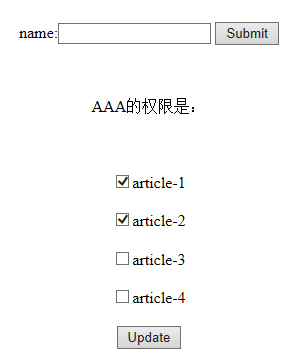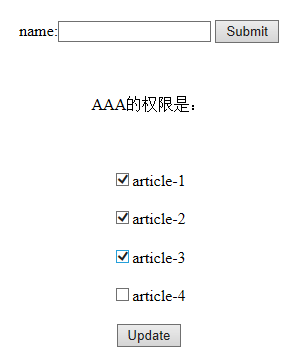許可權管理登入程式碼實現
阿新 • • 發佈:2018-11-16
功能實現:在頁面輸入給定的使用者名稱之一,可以顯示當前使用者的許可權,也可以在頁面更改該使用者的許可權,更新之後儲存。像下面這樣。

填寫使用者名稱提交:

顯示使用者AAA的許可權:

修改許可權(增加article3):

點選Update之後,許可權更新,下次訪問,輸入使用者名稱AAA提交後顯示:

提交使用者名稱,顯示使用者許可權和修改使用者許可權頁面:authority-manager.jsp
<%@ page language="java" import="java.util.*" pageEncoding="UTF-8"%>
<%@ taglib prefix="c" uri="http://java.sun.com/jsp/jstl/core" %>
<%
String path = request.getContextPath();
String basePath = request.getScheme()+"://"+request.getServerName()+":"+request.getServerPort()+path+"/";
%>
<!DOCTYPE HTML PUBLIC "-//W3C//DTD HTML 4.01 Transitional//EN">
<html>
<head>
<base href="<%=basePath%>">
<title>My JSP 'authority-manager.jsp' starting page</title>
<meta http-equiv="pragma" content="no-cache">
<meta http-equiv="cache-control" content="no-cache">
<meta http-equiv="expires" content="0">
<meta http-equiv="keywords" content="keyword1,keyword2,keyword3">
<meta http-equiv="description" content="This is my page">
<!--
<link rel="stylesheet" type="text/css" href="styles.css">
-->
</head>
<body>
<center>
<br><br>
<form action="AuthorityServlet?method=getAuthorities" method="post">
name:<input type="text" name="username"/>
<input type="submit" value="Submit"/>
</form>
<c:if test="${requestScope.user!=null }">
<br><br>
${requestScope.user.username}的許可權是:
<br><br>
<form action="AuthorityServlet?method=updateAuthorities" method="post">
<input type="hidden" name="username" value="${requestScope.user.username}"/>
<br><br>
<!-- 兩個迴圈:外層迴圈先將許可權都列出來,內層迴圈用於將對應使用者的對應許可權 -->
<c:forEach items="${authorities}" var="auth">
<c:set var="flag" value="false"></c:set>
<c:forEach items="${user.authorities}" var="ua">
<c:if test="${ua.url==auth.url }">
<c:set var="flag" value="true"></c:set>
</c:if>
</c:forEach>
<c:if test="${flag==true}">
<input type="checkbox" name="authority" value="${auth.url}" checked="checked"/>${auth.displayname}
</c:if>
<c:if test="${flag==false}">
<input type="checkbox" name="authority" value="${auth.url}" />${auth.displayname}
</c:if>
<br><br>
</c:forEach>
<input type="submit" value="Update">
</form>
</c:if>
</center>
</body>
</html>
Servlet實現類,AuthorityServlet.java
package javaweb.com.anthorityManage;
import java.io.IOException;
import java.io.PrintWriter;
import java.lang.reflect.InvocationTargetException;
import java.lang.reflect.Method;
import java.util.List;
import javax.servlet.ServletException;
import javax.servlet.http.HttpServlet;
import javax.servlet.http.HttpServletRequest;
import javax.servlet.http.HttpServletResponse;
public class AuthorityServlet extends HttpServlet {
public void doPost(HttpServletRequest request, HttpServletResponse response) throws ServletException, IOException {
//authority-manager.jsp中的method引數-->getAuthorities
String methodName=request.getParameter("method");
try {
//getClass-->Class型物件,獲得許可權為public的內部類(即為public class AuthorityServlet)
//getMethod返回Method型別的物件,每個Method型別的物件代表一個方法
//getMethod(String方法名稱,入口引數型別1.class,入口引數型別2.class)-->訪問指定名稱和引數型別的方法
Method method=getClass().getMethod(methodName, HttpServletRequest.class,HttpServletResponse.class);
//invoke(Object obj,Object...args)-->利用指定引數args執行指定物件obj中的該方法,返回值為Object型
//利用指定引數request,response執行method方法
method.invoke(this, request,response);
} catch (NoSuchMethodException | SecurityException e) {
e.printStackTrace();
} catch (IllegalAccessException e) {
e.printStackTrace();
} catch (IllegalArgumentException e) {
e.printStackTrace();
} catch (InvocationTargetException e) {
e.printStackTrace();
}
}
private UserDao userDao=new UserDao();
public void getAuthorities(HttpServletRequest request, HttpServletResponse response)throws ServletException, IOException{
//從請求引數中獲取使用者名稱
String username=request.getParameter("username");
//從userDao中獲取使用者名稱(帶有使用者的許可權資訊)
User user=userDao.get(username);
//將userDao中獲得的使用者名稱傳遞給request請求
request.setAttribute("user",user);
//userDao中獲取的許可權資訊新增到request中
request.setAttribute("authorities", userDao.getAuthorities());
//按照使用者名稱轉發到相應的許可權管理頁面
request.getRequestDispatcher("/jspTest/authority-manager.jsp").forward(request, response);
}
public void updateAuthorities(HttpServletRequest request, HttpServletResponse response)throws ServletException, IOException{
//從請求域獲得使用者名稱和相應的多個許可權
String username=request.getParameter("username");
//從客戶端request域獲得的許可權
String[] authorities=request.getParameterValues("authority");
List<Authority> authorityList=userDao.getAuthorities(authorities);
userDao.update(username, authorityList);
//request.getContextPath()-->返回站點的根路徑
response.sendRedirect(request.getContextPath()+"/jspTest/authority-manager.jsp");
}
}
UserDao類執行具體的事務操作,UserDao.java
package javaweb.com.anthorityManage;
import java.util.ArrayList;
import java.util.HashMap;
import java.util.List;
import java.util.Map;
//UserDao類執行具體的事務操作
public class UserDao {
private static Map<String,User> users;
private static List<Authority> authorities;
static{
authorities=new ArrayList<>();
authorities.add(new Authority("article-1","/jspTest/1.jsp"));
authorities.add(new Authority("article-2","/jspTest/2.jsp"));
authorities.add(new Authority("article-3","/jspTest/3.jsp"));
authorities.add(new Authority("article-4","/jspTest/4.jsp"));
users=new HashMap<String,User>();
User user1=new User("AAA",authorities.subList(0,2));
users.put("AAA",user1);
User user2=new User("BBB",authorities.subList(2,4));
users.put("BBB",user2);
}
//相當於String m1(){} 獲得users中的使用者姓名
User get(String username){
return users.get(username);
}
//更新使用者的許可權
void update(String username,List<Authority> authorities){
users.get(username).setAuthorities(authorities);
}
public List<Authority> getAuthorities(){
return authorities;
}
public List<Authority> getAuthorities(String[] urls){
List<Authority> authorities2=new ArrayList<>();
for(Authority authority:authorities){
if(urls!=null){
for(String url:urls){
//遍歷比較,如果url(請求域的)==許可權中儲存的url,則將請求域的許可權新增到authorities2中成為某個使用者名稱的許可權
if(url.equals(authority.getUrl())){
authorities2.add(authority);
}
}
}
}
return authorities2;
}
}
Authority.java
package javaweb.com.anthorityManage;
public class Authority {
private String displayname;
private String url;
public String getDisplayname() {
return displayname;
}
public void setDisplayname(String displayname) {
this.displayname = displayname;
}
public String getUrl() {
return url;
}
public void setUrl(String url) {
this.url = url;
}
public Authority(String displayname, String url) {
super();
this.displayname = displayname;
this.url = url;
}
public Authority(){}
}
User.java
package javaweb.com.anthorityManage;
import java.util.List;
public class User {
private String username;
private List<Authority> authorities;
public String getUsername() {
return username;
}
public void setUsername(String username) {
this.username = username;
}
public List<Authority> getAuthorities() {
return authorities;
}
public void setAuthorities(List<Authority> authorities) {
this.authorities = authorities;
}
public User(String username, List<Authority> authorities) {
super();
this.username = username;
this.authorities = authorities;
}
public User(){}
}
